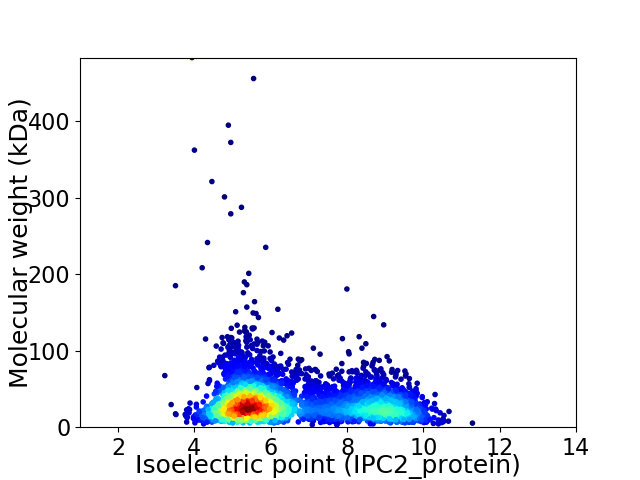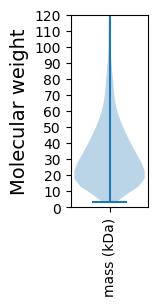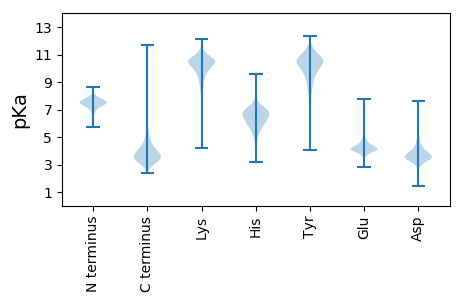
Caulobacter mirabilis
Taxonomy: cellular organisms; Bacteria; Proteobacteria; Alphaproteobacteria; Caulobacterales; Caulobacteraceae; Caulobacter
Average proteome isoelectric point is 6.58
Get precalculated fractions of proteins

Virtual 2D-PAGE plot for 4239 proteins (isoelectric point calculated using IPC2_protein)
Get csv file with sequences according to given criteria:
* You can choose from 21 different methods for calculating isoelectric point
Summary statistics related to proteome-wise predictions



Protein with the lowest isoelectric point:
>tr|A0A2D2AXM9|A0A2D2AXM9_9CAUL AraC family transcriptional regulator OS=Caulobacter mirabilis OX=69666 GN=CSW64_10070 PE=4 SV=1
MM1 pKa = 7.16PQATVSMIYY10 pKa = 10.05CVQQATGTDD19 pKa = 3.08AGVNEE24 pKa = 5.55AIAGLPEE31 pKa = 4.35LLLPGEE37 pKa = 4.33FGGMPLQAIRR47 pKa = 11.84ALPGVIAAVDD57 pKa = 3.53AARR60 pKa = 11.84ADD62 pKa = 3.88PDD64 pKa = 3.75DD65 pKa = 5.74LYY67 pKa = 10.37ITTSTGGGRR76 pKa = 11.84DD77 pKa = 3.36NAIWPSAGGVVQIQAGQSEE96 pKa = 4.83TPDD99 pKa = 3.04VTVAFDD105 pKa = 3.49HH106 pKa = 6.24SQNLSLWDD114 pKa = 3.84YY115 pKa = 11.65DD116 pKa = 4.29SVSDD120 pKa = 5.17DD121 pKa = 4.36DD122 pKa = 5.33LLGSVTMFASEE133 pKa = 3.93QGQGEE138 pKa = 4.19IAKK141 pKa = 9.56LAKK144 pKa = 10.46SPIEE148 pKa = 3.56NSYY151 pKa = 9.75YY152 pKa = 9.01YY153 pKa = 10.53VVYY156 pKa = 10.41RR157 pKa = 11.84VDD159 pKa = 3.01
MM1 pKa = 7.16PQATVSMIYY10 pKa = 10.05CVQQATGTDD19 pKa = 3.08AGVNEE24 pKa = 5.55AIAGLPEE31 pKa = 4.35LLLPGEE37 pKa = 4.33FGGMPLQAIRR47 pKa = 11.84ALPGVIAAVDD57 pKa = 3.53AARR60 pKa = 11.84ADD62 pKa = 3.88PDD64 pKa = 3.75DD65 pKa = 5.74LYY67 pKa = 10.37ITTSTGGGRR76 pKa = 11.84DD77 pKa = 3.36NAIWPSAGGVVQIQAGQSEE96 pKa = 4.83TPDD99 pKa = 3.04VTVAFDD105 pKa = 3.49HH106 pKa = 6.24SQNLSLWDD114 pKa = 3.84YY115 pKa = 11.65DD116 pKa = 4.29SVSDD120 pKa = 5.17DD121 pKa = 4.36DD122 pKa = 5.33LLGSVTMFASEE133 pKa = 3.93QGQGEE138 pKa = 4.19IAKK141 pKa = 9.56LAKK144 pKa = 10.46SPIEE148 pKa = 3.56NSYY151 pKa = 9.75YY152 pKa = 9.01YY153 pKa = 10.53VVYY156 pKa = 10.41RR157 pKa = 11.84VDD159 pKa = 3.01
Molecular weight: 16.73 kDa
Isoelectric point according different methods:
Protein with the highest isoelectric point:
>tr|A0A2D2B3N3|A0A2D2B3N3_9CAUL Protein tyrosine phosphatase OS=Caulobacter mirabilis OX=69666 GN=CSW64_04120 PE=4 SV=1
MM1 pKa = 7.69SKK3 pKa = 9.0RR4 pKa = 11.84TFQPSRR10 pKa = 11.84LVRR13 pKa = 11.84KK14 pKa = 9.11RR15 pKa = 11.84RR16 pKa = 11.84HH17 pKa = 4.53GFRR20 pKa = 11.84LRR22 pKa = 11.84MSTKK26 pKa = 10.23NGAKK30 pKa = 9.76IIARR34 pKa = 11.84RR35 pKa = 11.84RR36 pKa = 11.84AKK38 pKa = 9.93GRR40 pKa = 11.84KK41 pKa = 8.85RR42 pKa = 11.84LSAA45 pKa = 3.96
MM1 pKa = 7.69SKK3 pKa = 9.0RR4 pKa = 11.84TFQPSRR10 pKa = 11.84LVRR13 pKa = 11.84KK14 pKa = 9.11RR15 pKa = 11.84RR16 pKa = 11.84HH17 pKa = 4.53GFRR20 pKa = 11.84LRR22 pKa = 11.84MSTKK26 pKa = 10.23NGAKK30 pKa = 9.76IIARR34 pKa = 11.84RR35 pKa = 11.84RR36 pKa = 11.84AKK38 pKa = 9.93GRR40 pKa = 11.84KK41 pKa = 8.85RR42 pKa = 11.84LSAA45 pKa = 3.96
Molecular weight: 5.37 kDa
Isoelectric point according different methods:
Peptides (in silico digests for buttom-up proteomics)
Below you can find in silico digests of the whole proteome with Trypsin, Chymotrypsin, Trypsin+LysC, LysN, ArgC proteases suitable for different mass spec machines.| Try ESI |
 |
|---|
| ChTry ESI |
 |
|---|
| ArgC ESI |
 |
|---|
| LysN ESI |
 |
|---|
| TryLysC ESI |
 |
|---|
| Try MALDI |
 |
|---|
| ChTry MALDI |
 |
|---|
| ArgC MALDI |
 |
|---|
| LysN MALDI |
 |
|---|
| TryLysC MALDI |
 |
|---|
| Try LTQ |
 |
|---|
| ChTry LTQ |
 |
|---|
| ArgC LTQ |
 |
|---|
| LysN LTQ |
 |
|---|
| TryLysC LTQ |
 |
|---|
| Try MSlow |
 |
|---|
| ChTry MSlow |
 |
|---|
| ArgC MSlow |
 |
|---|
| LysN MSlow |
 |
|---|
| TryLysC MSlow |
 |
|---|
| Try MShigh |
 |
|---|
| ChTry MShigh |
 |
|---|
| ArgC MShigh |
 |
|---|
| LysN MShigh |
 |
|---|
| TryLysC MShigh |
 |
|---|
General Statistics
Number of major isoforms |
Number of additional isoforms |
Number of all proteins |
Number of amino acids |
Min. Seq. Length |
Max. Seq. Length |
Avg. Seq. Length |
Avg. Mol. Weight |
|---|---|---|---|---|---|---|---|
0 |
1376727 |
28 |
4922 |
324.8 |
34.9 |
Amino acid frequency
Ala |
Cys |
Asp |
Glu |
Phe |
Gly |
His |
Ile |
Lys |
Leu |
|---|---|---|---|---|---|---|---|---|---|
13.931 ± 0.061 | 0.699 ± 0.012 |
5.857 ± 0.03 | 5.469 ± 0.047 |
3.529 ± 0.024 | 9.33 ± 0.09 |
1.673 ± 0.021 | 4.251 ± 0.028 |
3.024 ± 0.035 | 9.998 ± 0.045 |
Met |
Asn |
Gln |
Pro |
Arg |
Ser |
Thr |
Val |
Trp |
Tyr |
|---|---|---|---|---|---|---|---|---|---|
2.154 ± 0.023 | 2.321 ± 0.031 |
5.563 ± 0.04 | 3.008 ± 0.022 |
7.447 ± 0.052 | 4.972 ± 0.04 |
5.403 ± 0.067 | 7.637 ± 0.033 |
1.522 ± 0.018 | 2.211 ± 0.022 |
Most of the basic statistics you can see at this page can be downloaded from this CSV file
Proteome-pI is available under Creative Commons Attribution-NoDerivs license, for more details see here
| Reference: Kozlowski LP. Proteome-pI 2.0: Proteome Isoelectric Point Database Update. Nucleic Acids Res. 2021, doi: 10.1093/nar/gkab944 | Contact: Lukasz P. Kozlowski |
